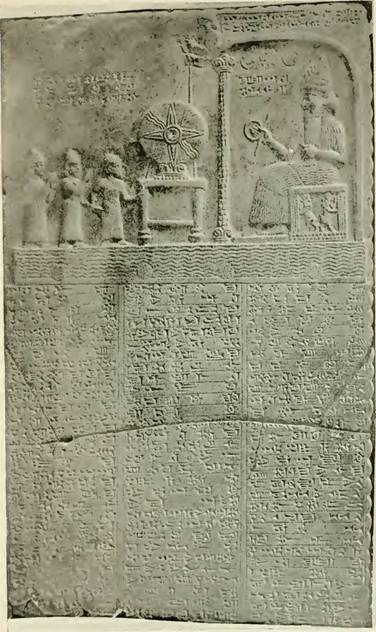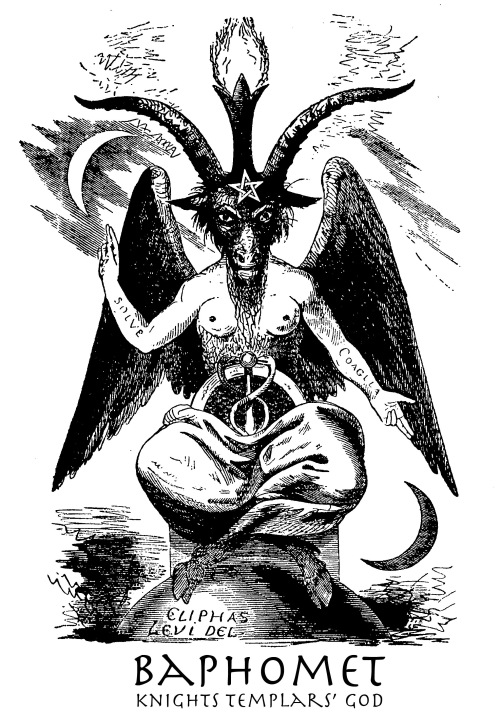From Uz to Baphomet
“The gazelle or antelope was a mythological animal in Babylonia so far as it represented Ea, who is entitled ‘the princely gazelle ’ and ‘the gazelle who gives the earth.’ But this animal was also appropriated to Mul-lil, the god of Nippur, who was specially called the ‘gazelle god.’
It is likely, therefore, that this animal had been worshipped totemically at Nippur. Scores of early cylinders represent it being offered in sacrifice to a god, and bas-reliefs and other carvings show it reposing in the arms of various deities.

Limestone tablet depicting king Nabu-aplu-iddina being led into the presence of Šamaš, the sun god; 860 BCE-850 BCE.
Šamaš sits in the E-babbar shrine and holds the rod and ring symbols of kingship (BM 91000). © The British Museum.
http://oracc.museum.upenn.edu/amgg/listofdeities/utu/
Alternative interpretation, from Lewis Spence, Myths and Legends of Babylonia and Assyria, London, 1917, p. 292.
“A god called Uz has for his name the Akkadian word for goat. Mr Hormuzd Rassam found a sculptured stone tablet in a temple of the sun-god at Sippara on which was an inscription to Sin, Shamash, and Ishtar, as being “set as companions at the approach to the deep in sight of the god Uz.”
This god Uz is depicted as sitting on a throne watching the revolution of the solar disc, which is placed upon a table and made to revolve by means of a rope or string. He is clad in a robe of goat-skin.”
http://www.wisdomlib.org/mesopotamian/book/myths-and-legends-of-babylonia-and-assyria/d/doc7171.html
The goat, too, seems to have been peculiarly sacred, and formed one of the signs of the zodiac. A god called Uz has for his name the Akkadian word for goat. Mr Hormuzd Rassam found a sculptured stone tablet in a temple of the sun-god at Sippara on which was an inscription to Sin, Shamash, and Ishtar, as being “set as companions at the approach to the deep in sight of the god Uz.”
This god Uz is depicted as sitting on a throne watching the revolution of the solar disc, which is placed upon a table and made to revolve by means of a rope or string. He is clad in a robe of goat-skin.
This cult of the goat appears to be of very ancient origin, and the strange thing is that it seems to have found its way into mediaeval and even into modern magic and pseudo-religion. There is very little doubt that it is the Baphomet of the knights-templar and the Sabbatic goat of the witchcraft of the Middle Ages.
It seems almost certain that when the Crusaders sojourned in Asia-Minor they came into contact with the remains of the old Babylonian cult.
When Philip the Fair of France arraigned them on a charge of heresy a great deal of curious evidence was extorted from them regarding the worship of an idol that they kept in their lodges.
The real character of this they seemed unable to explain. It was said which the image was made in the likeness of ‘Baphomet,’ which name was said to be a corruption of Mahomet, the general Christian name at that period for a pagan idol, although others give a Greek derivation for the word.
This figure was often described as possessing a goat’s head and horns. That, too, the Sabbatic goat of the Middle Ages was of Eastern and probably Babylonian origin is scarcely to be doubted. At the witch orgies in France and elsewhere those who were afterwards brought to book for their sorceries declared that Satan appeared to them in the shape of a goat and that they worshipped him in this form.
The Sabbatic meetings during the fifteenth century in the wood of Moffiaines, near Arras, had as their centre a goat-demon with a human countenance, and a like fiend was adored in Germany and in Scotland. From all this it is clear that the Sabbatic goat must have had some connexion with the East.
Eliphas Levi drew a picture of the Baphomet or Sabbatic goat to accompany one of his occult works, and strangely enough the symbols that he adorns it with are peculiarly Oriental—moreover the sun-disc figures in the drawing.
Now Levi knew nothing of Babylonian mythology, although he was moderately versed in the mythology of modern occultism, and it would seem that if he drew his information from modern or mediaeval sources that these must have been in direct line from Babylonian lore.”
Lewis Spence, Myths and Legends of Babylonia and Assyria, 1917, pp. 292-4.

